Reflecting on Leadership Approaches: A Critical Analysis Report
VerifiedAdded on 2021/02/21
|8
|2408
|40
Report
AI Summary
This report provides a comprehensive analysis of leadership approaches, focusing on situational, contingency, and transformational leadership styles. The author reflects on critical leadership studies, exploring how these approaches can inform their personal leadership style. The report examines the strengths and applications of each approach, including how they can be used to manage trust issues, handle urgent situations, and drive organizational change. It also discusses Fiedler's contingency model and Hersey and Blanchard's leadership styles, offering insights into how to adapt leadership strategies to various situations. The conclusion emphasizes the importance of leadership in influencing individuals and groups to achieve specific goals, highlighting the practical application of different leadership approaches in a dynamic business environment. This report is contributed by a student to Desklib, a platform providing AI-based study tools for students.
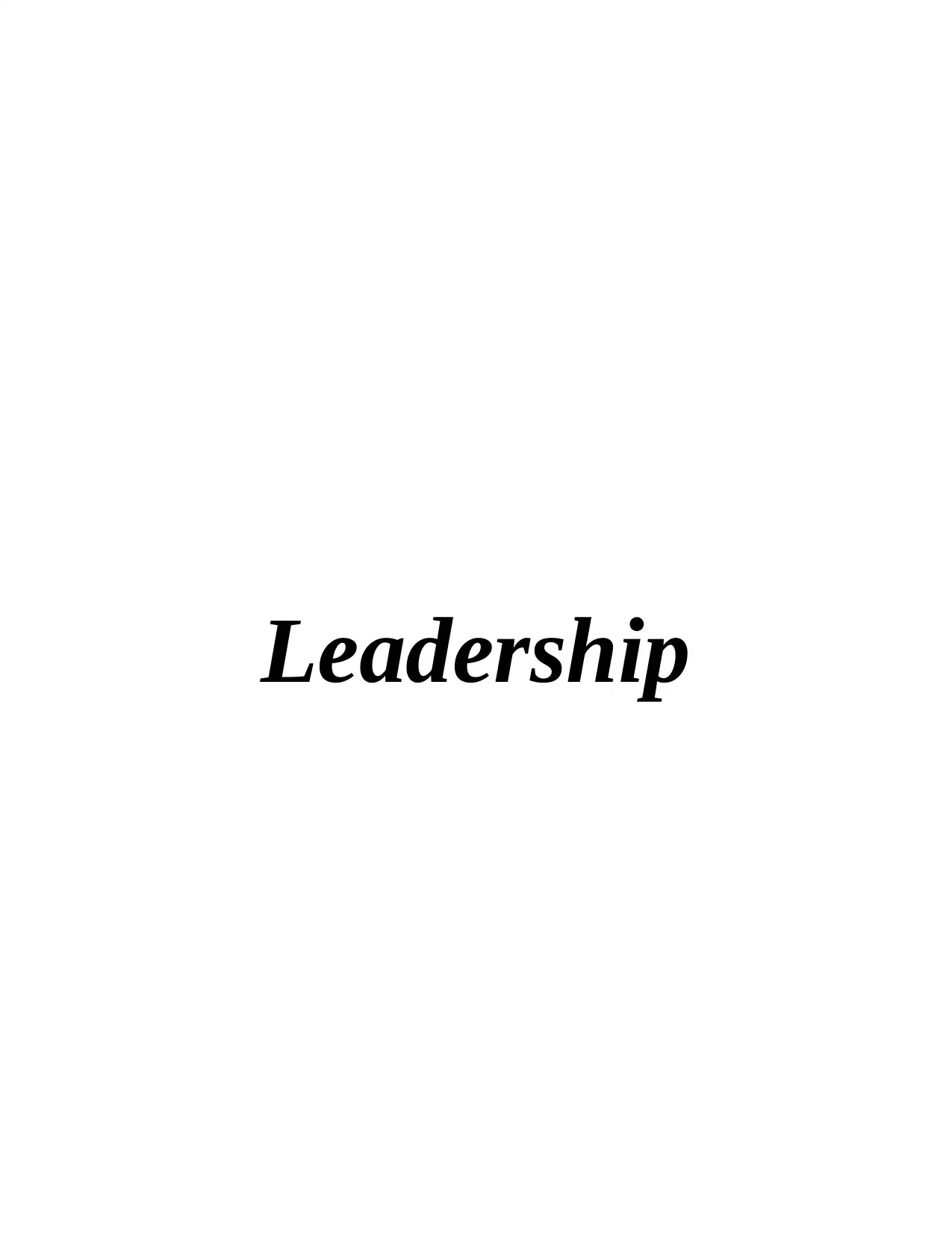
Leadership
Paraphrase This Document
Need a fresh take? Get an instant paraphrase of this document with our AI Paraphraser
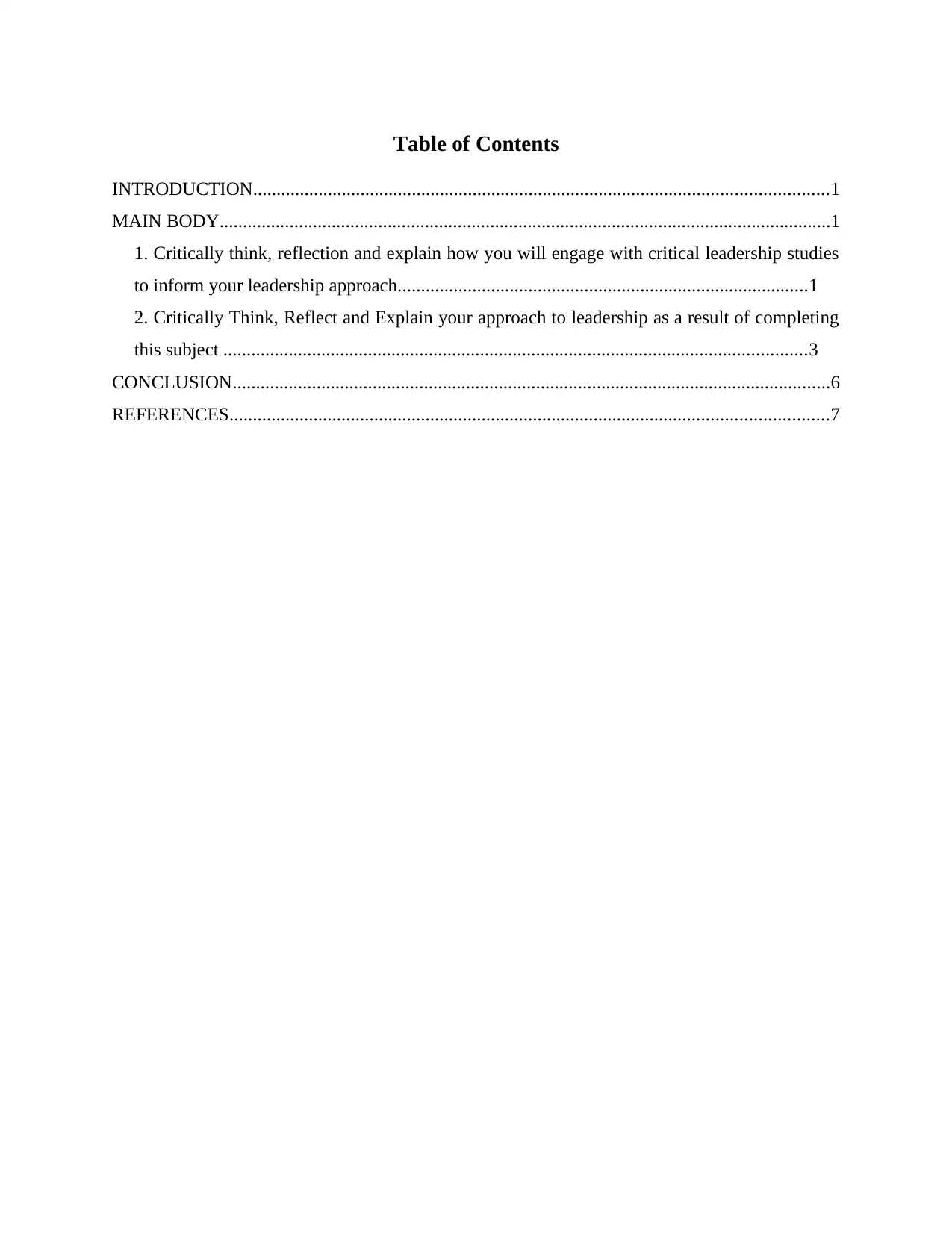
Table of Contents
INTRODUCTION...........................................................................................................................1
MAIN BODY...................................................................................................................................1
1. Critically think, reflection and explain how you will engage with critical leadership studies
to inform your leadership approach........................................................................................1
2. Critically Think, Reflect and Explain your approach to leadership as a result of completing
this subject .............................................................................................................................3
CONCLUSION................................................................................................................................6
REFERENCES................................................................................................................................7
INTRODUCTION...........................................................................................................................1
MAIN BODY...................................................................................................................................1
1. Critically think, reflection and explain how you will engage with critical leadership studies
to inform your leadership approach........................................................................................1
2. Critically Think, Reflect and Explain your approach to leadership as a result of completing
this subject .............................................................................................................................3
CONCLUSION................................................................................................................................6
REFERENCES................................................................................................................................7
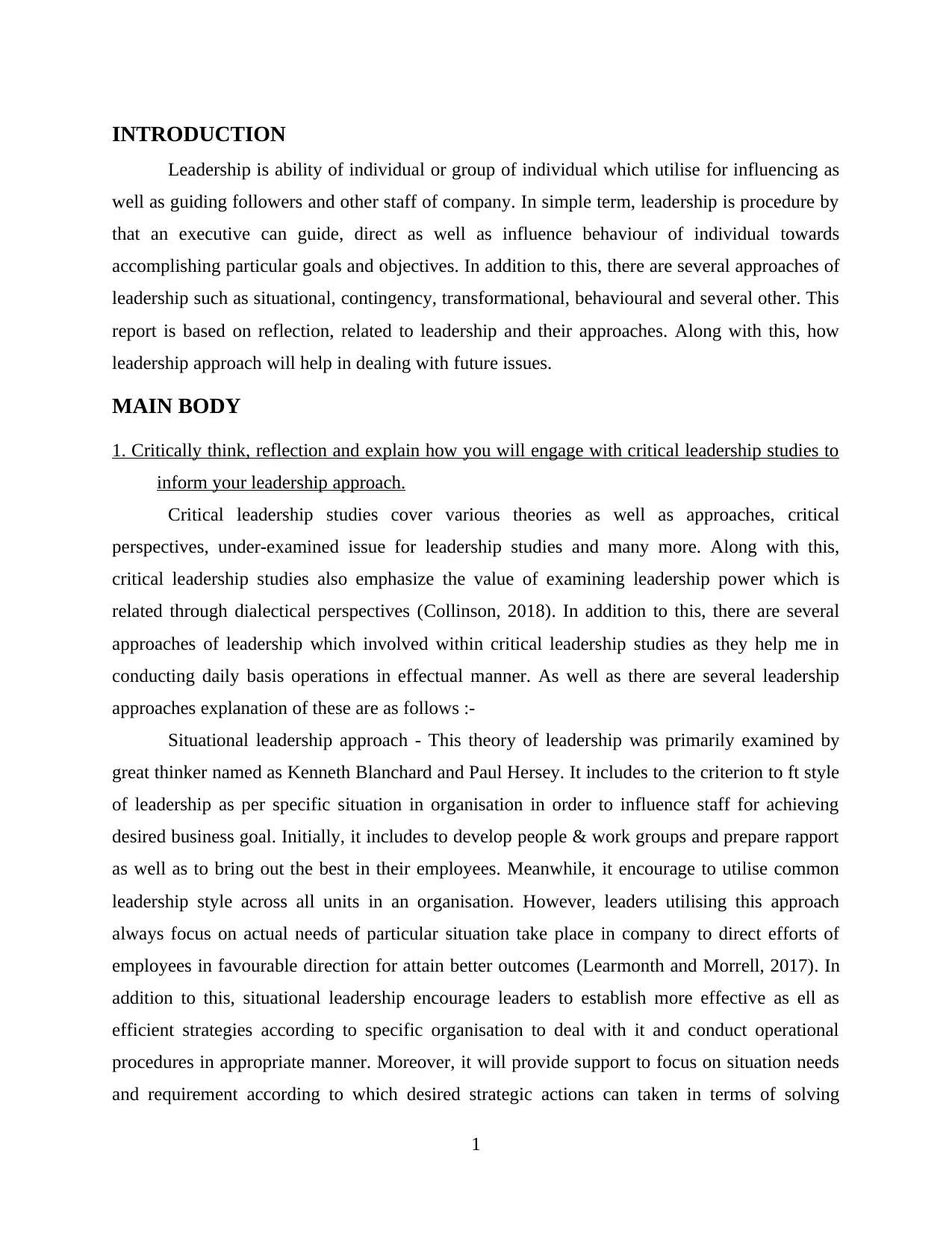
INTRODUCTION
Leadership is ability of individual or group of individual which utilise for influencing as
well as guiding followers and other staff of company. In simple term, leadership is procedure by
that an executive can guide, direct as well as influence behaviour of individual towards
accomplishing particular goals and objectives. In addition to this, there are several approaches of
leadership such as situational, contingency, transformational, behavioural and several other. This
report is based on reflection, related to leadership and their approaches. Along with this, how
leadership approach will help in dealing with future issues.
MAIN BODY
1. Critically think, reflection and explain how you will engage with critical leadership studies to
inform your leadership approach.
Critical leadership studies cover various theories as well as approaches, critical
perspectives, under-examined issue for leadership studies and many more. Along with this,
critical leadership studies also emphasize the value of examining leadership power which is
related through dialectical perspectives (Collinson, 2018). In addition to this, there are several
approaches of leadership which involved within critical leadership studies as they help me in
conducting daily basis operations in effectual manner. As well as there are several leadership
approaches explanation of these are as follows :-
Situational leadership approach - This theory of leadership was primarily examined by
great thinker named as Kenneth Blanchard and Paul Hersey. It includes to the criterion to ft style
of leadership as per specific situation in organisation in order to influence staff for achieving
desired business goal. Initially, it includes to develop people & work groups and prepare rapport
as well as to bring out the best in their employees. Meanwhile, it encourage to utilise common
leadership style across all units in an organisation. However, leaders utilising this approach
always focus on actual needs of particular situation take place in company to direct efforts of
employees in favourable direction for attain better outcomes (Learmonth and Morrell, 2017). In
addition to this, situational leadership encourage leaders to establish more effective as ell as
efficient strategies according to specific organisation to deal with it and conduct operational
procedures in appropriate manner. Moreover, it will provide support to focus on situation needs
and requirement according to which desired strategic actions can taken in terms of solving
1
Leadership is ability of individual or group of individual which utilise for influencing as
well as guiding followers and other staff of company. In simple term, leadership is procedure by
that an executive can guide, direct as well as influence behaviour of individual towards
accomplishing particular goals and objectives. In addition to this, there are several approaches of
leadership such as situational, contingency, transformational, behavioural and several other. This
report is based on reflection, related to leadership and their approaches. Along with this, how
leadership approach will help in dealing with future issues.
MAIN BODY
1. Critically think, reflection and explain how you will engage with critical leadership studies to
inform your leadership approach.
Critical leadership studies cover various theories as well as approaches, critical
perspectives, under-examined issue for leadership studies and many more. Along with this,
critical leadership studies also emphasize the value of examining leadership power which is
related through dialectical perspectives (Collinson, 2018). In addition to this, there are several
approaches of leadership which involved within critical leadership studies as they help me in
conducting daily basis operations in effectual manner. As well as there are several leadership
approaches explanation of these are as follows :-
Situational leadership approach - This theory of leadership was primarily examined by
great thinker named as Kenneth Blanchard and Paul Hersey. It includes to the criterion to ft style
of leadership as per specific situation in organisation in order to influence staff for achieving
desired business goal. Initially, it includes to develop people & work groups and prepare rapport
as well as to bring out the best in their employees. Meanwhile, it encourage to utilise common
leadership style across all units in an organisation. However, leaders utilising this approach
always focus on actual needs of particular situation take place in company to direct efforts of
employees in favourable direction for attain better outcomes (Learmonth and Morrell, 2017). In
addition to this, situational leadership encourage leaders to establish more effective as ell as
efficient strategies according to specific organisation to deal with it and conduct operational
procedures in appropriate manner. Moreover, it will provide support to focus on situation needs
and requirement according to which desired strategic actions can taken in terms of solving
1
⊘ This is a preview!⊘
Do you want full access?
Subscribe today to unlock all pages.

Trusted by 1+ million students worldwide
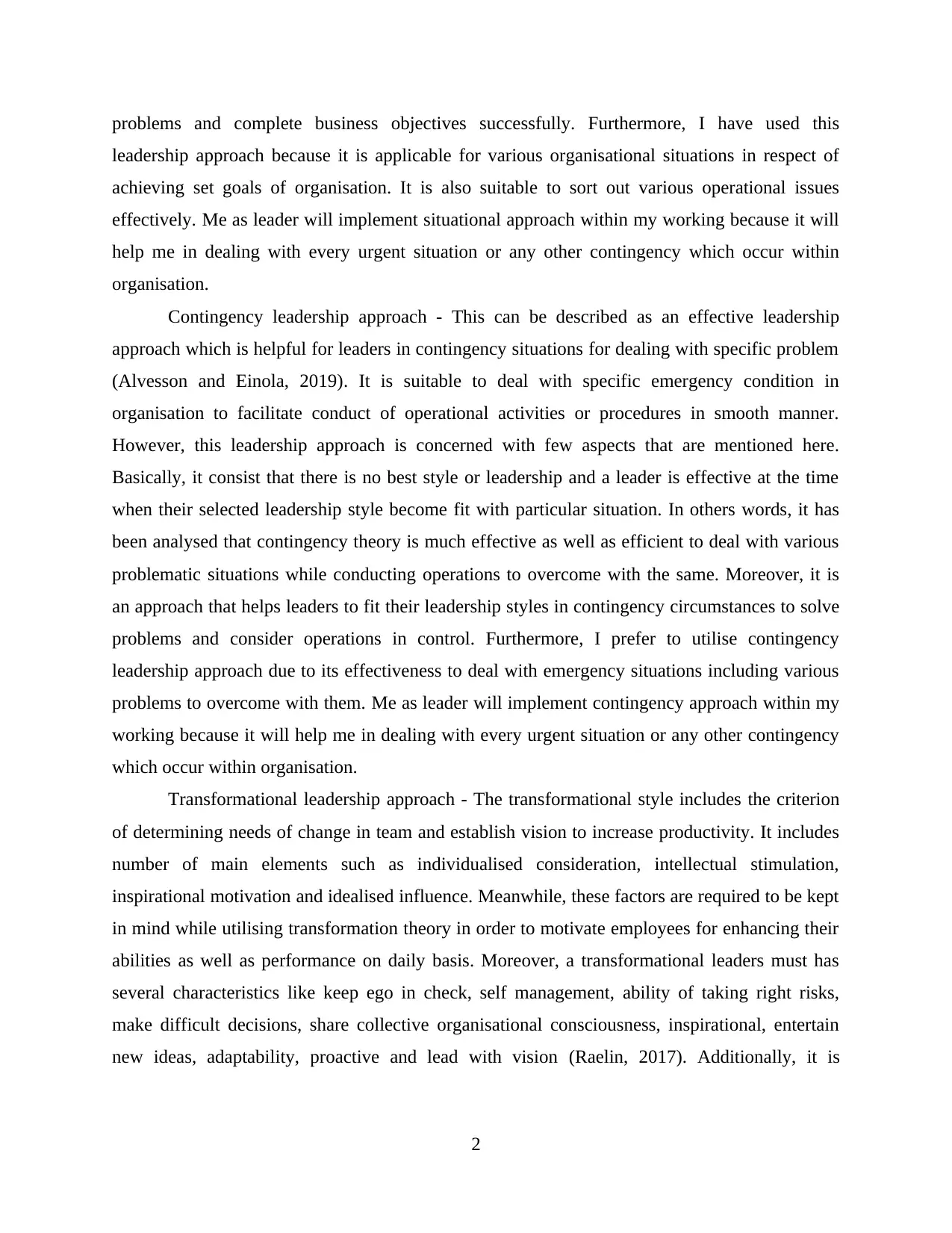
problems and complete business objectives successfully. Furthermore, I have used this
leadership approach because it is applicable for various organisational situations in respect of
achieving set goals of organisation. It is also suitable to sort out various operational issues
effectively. Me as leader will implement situational approach within my working because it will
help me in dealing with every urgent situation or any other contingency which occur within
organisation.
Contingency leadership approach - This can be described as an effective leadership
approach which is helpful for leaders in contingency situations for dealing with specific problem
(Alvesson and Einola, 2019). It is suitable to deal with specific emergency condition in
organisation to facilitate conduct of operational activities or procedures in smooth manner.
However, this leadership approach is concerned with few aspects that are mentioned here.
Basically, it consist that there is no best style or leadership and a leader is effective at the time
when their selected leadership style become fit with particular situation. In others words, it has
been analysed that contingency theory is much effective as well as efficient to deal with various
problematic situations while conducting operations to overcome with the same. Moreover, it is
an approach that helps leaders to fit their leadership styles in contingency circumstances to solve
problems and consider operations in control. Furthermore, I prefer to utilise contingency
leadership approach due to its effectiveness to deal with emergency situations including various
problems to overcome with them. Me as leader will implement contingency approach within my
working because it will help me in dealing with every urgent situation or any other contingency
which occur within organisation.
Transformational leadership approach - The transformational style includes the criterion
of determining needs of change in team and establish vision to increase productivity. It includes
number of main elements such as individualised consideration, intellectual stimulation,
inspirational motivation and idealised influence. Meanwhile, these factors are required to be kept
in mind while utilising transformation theory in order to motivate employees for enhancing their
abilities as well as performance on daily basis. Moreover, a transformational leaders must has
several characteristics like keep ego in check, self management, ability of taking right risks,
make difficult decisions, share collective organisational consciousness, inspirational, entertain
new ideas, adaptability, proactive and lead with vision (Raelin, 2017). Additionally, it is
2
leadership approach because it is applicable for various organisational situations in respect of
achieving set goals of organisation. It is also suitable to sort out various operational issues
effectively. Me as leader will implement situational approach within my working because it will
help me in dealing with every urgent situation or any other contingency which occur within
organisation.
Contingency leadership approach - This can be described as an effective leadership
approach which is helpful for leaders in contingency situations for dealing with specific problem
(Alvesson and Einola, 2019). It is suitable to deal with specific emergency condition in
organisation to facilitate conduct of operational activities or procedures in smooth manner.
However, this leadership approach is concerned with few aspects that are mentioned here.
Basically, it consist that there is no best style or leadership and a leader is effective at the time
when their selected leadership style become fit with particular situation. In others words, it has
been analysed that contingency theory is much effective as well as efficient to deal with various
problematic situations while conducting operations to overcome with the same. Moreover, it is
an approach that helps leaders to fit their leadership styles in contingency circumstances to solve
problems and consider operations in control. Furthermore, I prefer to utilise contingency
leadership approach due to its effectiveness to deal with emergency situations including various
problems to overcome with them. Me as leader will implement contingency approach within my
working because it will help me in dealing with every urgent situation or any other contingency
which occur within organisation.
Transformational leadership approach - The transformational style includes the criterion
of determining needs of change in team and establish vision to increase productivity. It includes
number of main elements such as individualised consideration, intellectual stimulation,
inspirational motivation and idealised influence. Meanwhile, these factors are required to be kept
in mind while utilising transformation theory in order to motivate employees for enhancing their
abilities as well as performance on daily basis. Moreover, a transformational leaders must has
several characteristics like keep ego in check, self management, ability of taking right risks,
make difficult decisions, share collective organisational consciousness, inspirational, entertain
new ideas, adaptability, proactive and lead with vision (Raelin, 2017). Additionally, it is
2
Paraphrase This Document
Need a fresh take? Get an instant paraphrase of this document with our AI Paraphraser
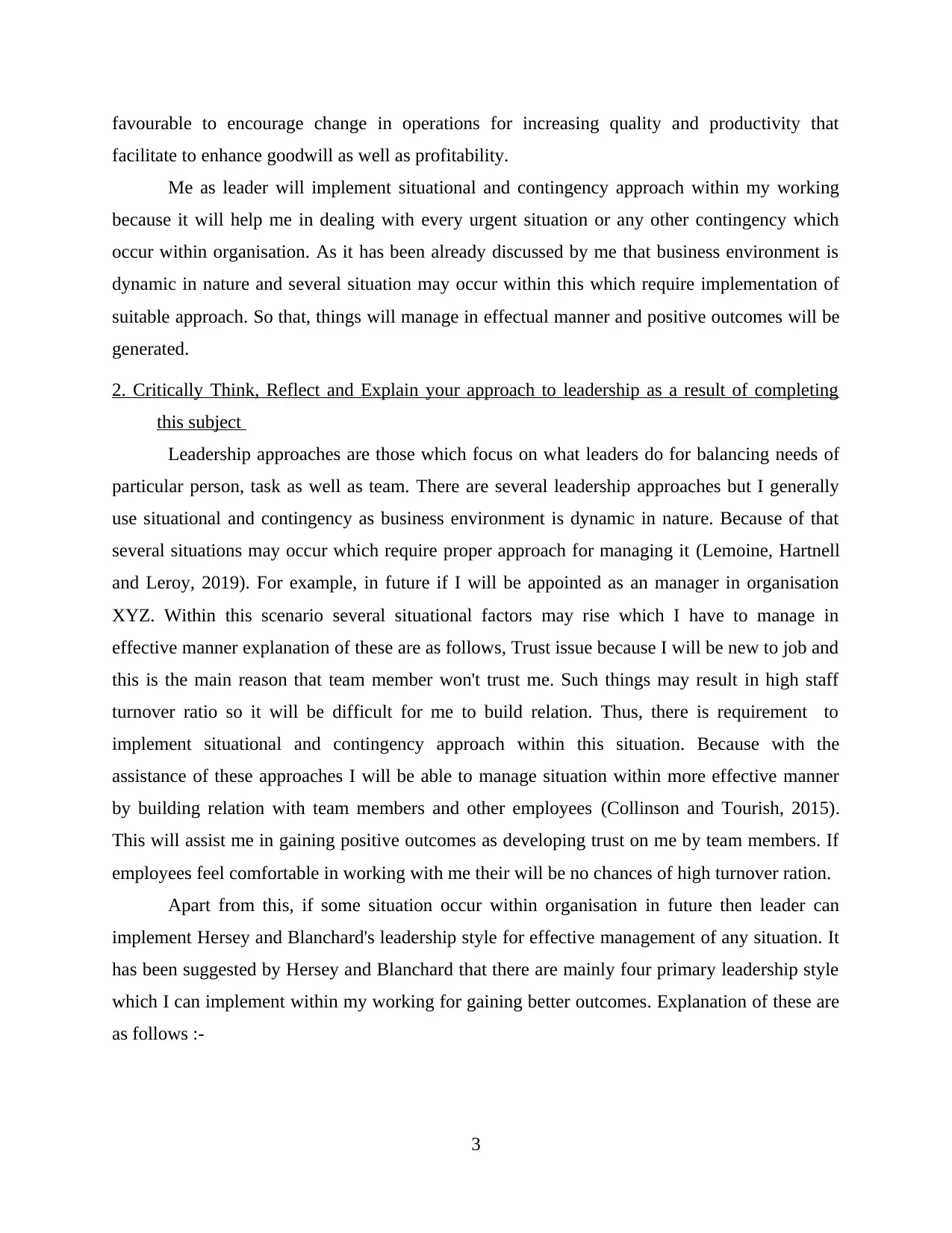
favourable to encourage change in operations for increasing quality and productivity that
facilitate to enhance goodwill as well as profitability.
Me as leader will implement situational and contingency approach within my working
because it will help me in dealing with every urgent situation or any other contingency which
occur within organisation. As it has been already discussed by me that business environment is
dynamic in nature and several situation may occur within this which require implementation of
suitable approach. So that, things will manage in effectual manner and positive outcomes will be
generated.
2. Critically Think, Reflect and Explain your approach to leadership as a result of completing
this subject
Leadership approaches are those which focus on what leaders do for balancing needs of
particular person, task as well as team. There are several leadership approaches but I generally
use situational and contingency as business environment is dynamic in nature. Because of that
several situations may occur which require proper approach for managing it (Lemoine, Hartnell
and Leroy, 2019). For example, in future if I will be appointed as an manager in organisation
XYZ. Within this scenario several situational factors may rise which I have to manage in
effective manner explanation of these are as follows, Trust issue because I will be new to job and
this is the main reason that team member won't trust me. Such things may result in high staff
turnover ratio so it will be difficult for me to build relation. Thus, there is requirement to
implement situational and contingency approach within this situation. Because with the
assistance of these approaches I will be able to manage situation within more effective manner
by building relation with team members and other employees (Collinson and Tourish, 2015).
This will assist me in gaining positive outcomes as developing trust on me by team members. If
employees feel comfortable in working with me their will be no chances of high turnover ration.
Apart from this, if some situation occur within organisation in future then leader can
implement Hersey and Blanchard's leadership style for effective management of any situation. It
has been suggested by Hersey and Blanchard that there are mainly four primary leadership style
which I can implement within my working for gaining better outcomes. Explanation of these are
as follows :-
3
facilitate to enhance goodwill as well as profitability.
Me as leader will implement situational and contingency approach within my working
because it will help me in dealing with every urgent situation or any other contingency which
occur within organisation. As it has been already discussed by me that business environment is
dynamic in nature and several situation may occur within this which require implementation of
suitable approach. So that, things will manage in effectual manner and positive outcomes will be
generated.
2. Critically Think, Reflect and Explain your approach to leadership as a result of completing
this subject
Leadership approaches are those which focus on what leaders do for balancing needs of
particular person, task as well as team. There are several leadership approaches but I generally
use situational and contingency as business environment is dynamic in nature. Because of that
several situations may occur which require proper approach for managing it (Lemoine, Hartnell
and Leroy, 2019). For example, in future if I will be appointed as an manager in organisation
XYZ. Within this scenario several situational factors may rise which I have to manage in
effective manner explanation of these are as follows, Trust issue because I will be new to job and
this is the main reason that team member won't trust me. Such things may result in high staff
turnover ratio so it will be difficult for me to build relation. Thus, there is requirement to
implement situational and contingency approach within this situation. Because with the
assistance of these approaches I will be able to manage situation within more effective manner
by building relation with team members and other employees (Collinson and Tourish, 2015).
This will assist me in gaining positive outcomes as developing trust on me by team members. If
employees feel comfortable in working with me their will be no chances of high turnover ration.
Apart from this, if some situation occur within organisation in future then leader can
implement Hersey and Blanchard's leadership style for effective management of any situation. It
has been suggested by Hersey and Blanchard that there are mainly four primary leadership style
which I can implement within my working for gaining better outcomes. Explanation of these are
as follows :-
3
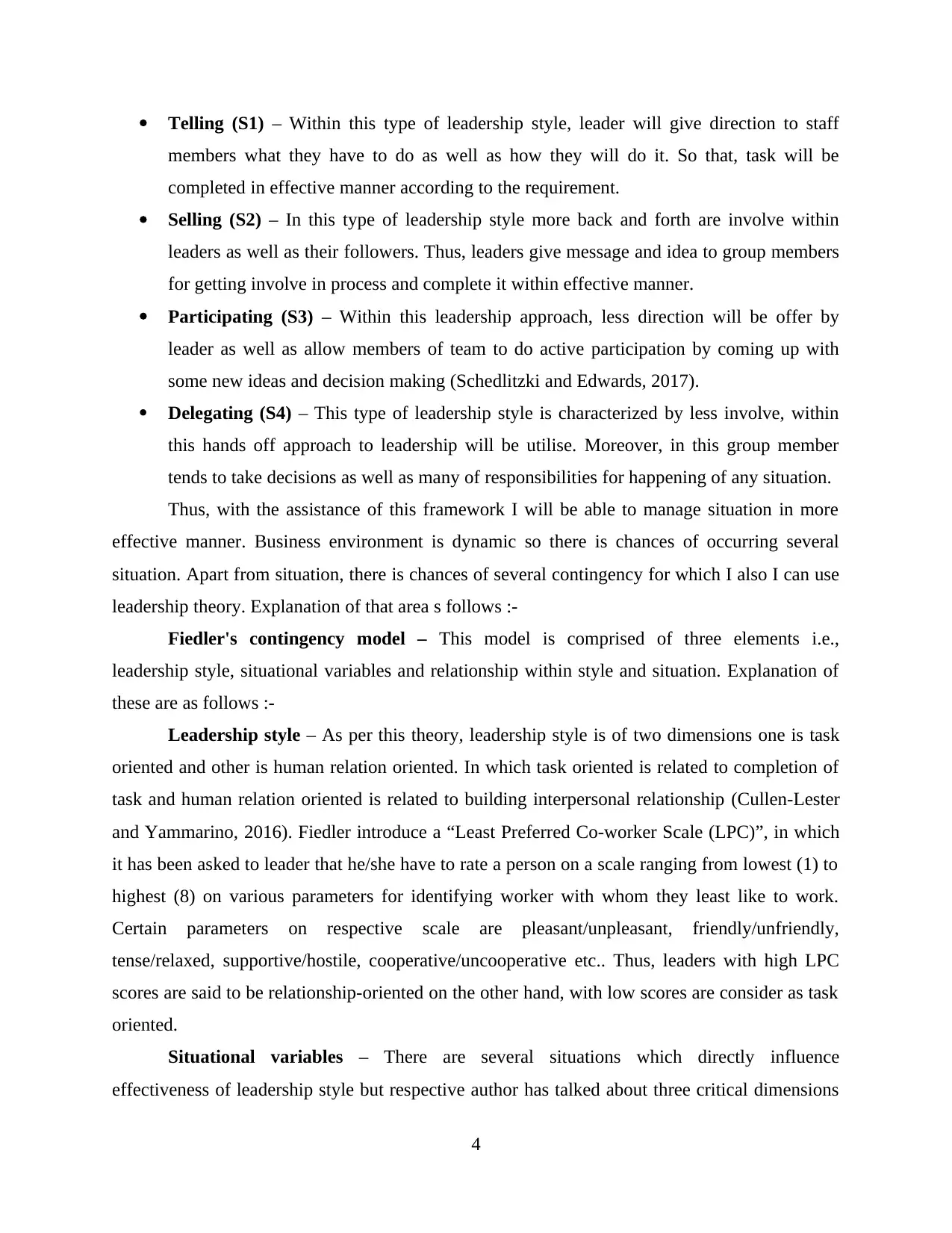
Telling (S1) – Within this type of leadership style, leader will give direction to staff
members what they have to do as well as how they will do it. So that, task will be
completed in effective manner according to the requirement.
Selling (S2) – In this type of leadership style more back and forth are involve within
leaders as well as their followers. Thus, leaders give message and idea to group members
for getting involve in process and complete it within effective manner.
Participating (S3) – Within this leadership approach, less direction will be offer by
leader as well as allow members of team to do active participation by coming up with
some new ideas and decision making (Schedlitzki and Edwards, 2017).
Delegating (S4) – This type of leadership style is characterized by less involve, within
this hands off approach to leadership will be utilise. Moreover, in this group member
tends to take decisions as well as many of responsibilities for happening of any situation.
Thus, with the assistance of this framework I will be able to manage situation in more
effective manner. Business environment is dynamic so there is chances of occurring several
situation. Apart from situation, there is chances of several contingency for which I also I can use
leadership theory. Explanation of that area s follows :-
Fiedler's contingency model – This model is comprised of three elements i.e.,
leadership style, situational variables and relationship within style and situation. Explanation of
these are as follows :-
Leadership style – As per this theory, leadership style is of two dimensions one is task
oriented and other is human relation oriented. In which task oriented is related to completion of
task and human relation oriented is related to building interpersonal relationship (Cullen-Lester
and Yammarino, 2016). Fiedler introduce a “Least Preferred Co-worker Scale (LPC)”, in which
it has been asked to leader that he/she have to rate a person on a scale ranging from lowest (1) to
highest (8) on various parameters for identifying worker with whom they least like to work.
Certain parameters on respective scale are pleasant/unpleasant, friendly/unfriendly,
tense/relaxed, supportive/hostile, cooperative/uncooperative etc.. Thus, leaders with high LPC
scores are said to be relationship-oriented on the other hand, with low scores are consider as task
oriented.
Situational variables – There are several situations which directly influence
effectiveness of leadership style but respective author has talked about three critical dimensions
4
members what they have to do as well as how they will do it. So that, task will be
completed in effective manner according to the requirement.
Selling (S2) – In this type of leadership style more back and forth are involve within
leaders as well as their followers. Thus, leaders give message and idea to group members
for getting involve in process and complete it within effective manner.
Participating (S3) – Within this leadership approach, less direction will be offer by
leader as well as allow members of team to do active participation by coming up with
some new ideas and decision making (Schedlitzki and Edwards, 2017).
Delegating (S4) – This type of leadership style is characterized by less involve, within
this hands off approach to leadership will be utilise. Moreover, in this group member
tends to take decisions as well as many of responsibilities for happening of any situation.
Thus, with the assistance of this framework I will be able to manage situation in more
effective manner. Business environment is dynamic so there is chances of occurring several
situation. Apart from situation, there is chances of several contingency for which I also I can use
leadership theory. Explanation of that area s follows :-
Fiedler's contingency model – This model is comprised of three elements i.e.,
leadership style, situational variables and relationship within style and situation. Explanation of
these are as follows :-
Leadership style – As per this theory, leadership style is of two dimensions one is task
oriented and other is human relation oriented. In which task oriented is related to completion of
task and human relation oriented is related to building interpersonal relationship (Cullen-Lester
and Yammarino, 2016). Fiedler introduce a “Least Preferred Co-worker Scale (LPC)”, in which
it has been asked to leader that he/she have to rate a person on a scale ranging from lowest (1) to
highest (8) on various parameters for identifying worker with whom they least like to work.
Certain parameters on respective scale are pleasant/unpleasant, friendly/unfriendly,
tense/relaxed, supportive/hostile, cooperative/uncooperative etc.. Thus, leaders with high LPC
scores are said to be relationship-oriented on the other hand, with low scores are consider as task
oriented.
Situational variables – There are several situations which directly influence
effectiveness of leadership style but respective author has talked about three critical dimensions
4
⊘ This is a preview!⊘
Do you want full access?
Subscribe today to unlock all pages.

Trusted by 1+ million students worldwide
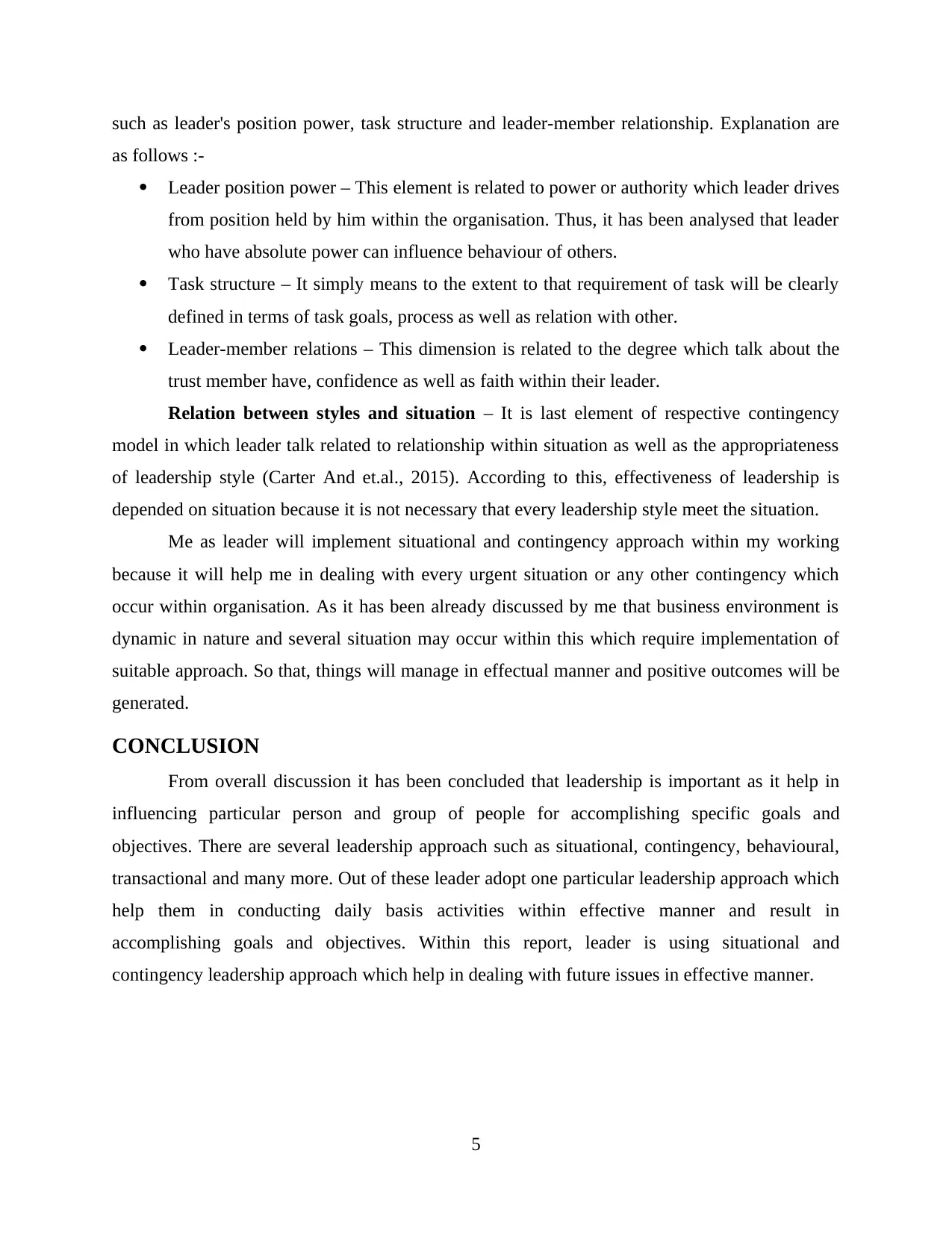
such as leader's position power, task structure and leader-member relationship. Explanation are
as follows :-
Leader position power – This element is related to power or authority which leader drives
from position held by him within the organisation. Thus, it has been analysed that leader
who have absolute power can influence behaviour of others.
Task structure – It simply means to the extent to that requirement of task will be clearly
defined in terms of task goals, process as well as relation with other.
Leader-member relations – This dimension is related to the degree which talk about the
trust member have, confidence as well as faith within their leader.
Relation between styles and situation – It is last element of respective contingency
model in which leader talk related to relationship within situation as well as the appropriateness
of leadership style (Carter And et.al., 2015). According to this, effectiveness of leadership is
depended on situation because it is not necessary that every leadership style meet the situation.
Me as leader will implement situational and contingency approach within my working
because it will help me in dealing with every urgent situation or any other contingency which
occur within organisation. As it has been already discussed by me that business environment is
dynamic in nature and several situation may occur within this which require implementation of
suitable approach. So that, things will manage in effectual manner and positive outcomes will be
generated.
CONCLUSION
From overall discussion it has been concluded that leadership is important as it help in
influencing particular person and group of people for accomplishing specific goals and
objectives. There are several leadership approach such as situational, contingency, behavioural,
transactional and many more. Out of these leader adopt one particular leadership approach which
help them in conducting daily basis activities within effective manner and result in
accomplishing goals and objectives. Within this report, leader is using situational and
contingency leadership approach which help in dealing with future issues in effective manner.
5
as follows :-
Leader position power – This element is related to power or authority which leader drives
from position held by him within the organisation. Thus, it has been analysed that leader
who have absolute power can influence behaviour of others.
Task structure – It simply means to the extent to that requirement of task will be clearly
defined in terms of task goals, process as well as relation with other.
Leader-member relations – This dimension is related to the degree which talk about the
trust member have, confidence as well as faith within their leader.
Relation between styles and situation – It is last element of respective contingency
model in which leader talk related to relationship within situation as well as the appropriateness
of leadership style (Carter And et.al., 2015). According to this, effectiveness of leadership is
depended on situation because it is not necessary that every leadership style meet the situation.
Me as leader will implement situational and contingency approach within my working
because it will help me in dealing with every urgent situation or any other contingency which
occur within organisation. As it has been already discussed by me that business environment is
dynamic in nature and several situation may occur within this which require implementation of
suitable approach. So that, things will manage in effectual manner and positive outcomes will be
generated.
CONCLUSION
From overall discussion it has been concluded that leadership is important as it help in
influencing particular person and group of people for accomplishing specific goals and
objectives. There are several leadership approach such as situational, contingency, behavioural,
transactional and many more. Out of these leader adopt one particular leadership approach which
help them in conducting daily basis activities within effective manner and result in
accomplishing goals and objectives. Within this report, leader is using situational and
contingency leadership approach which help in dealing with future issues in effective manner.
5
Paraphrase This Document
Need a fresh take? Get an instant paraphrase of this document with our AI Paraphraser
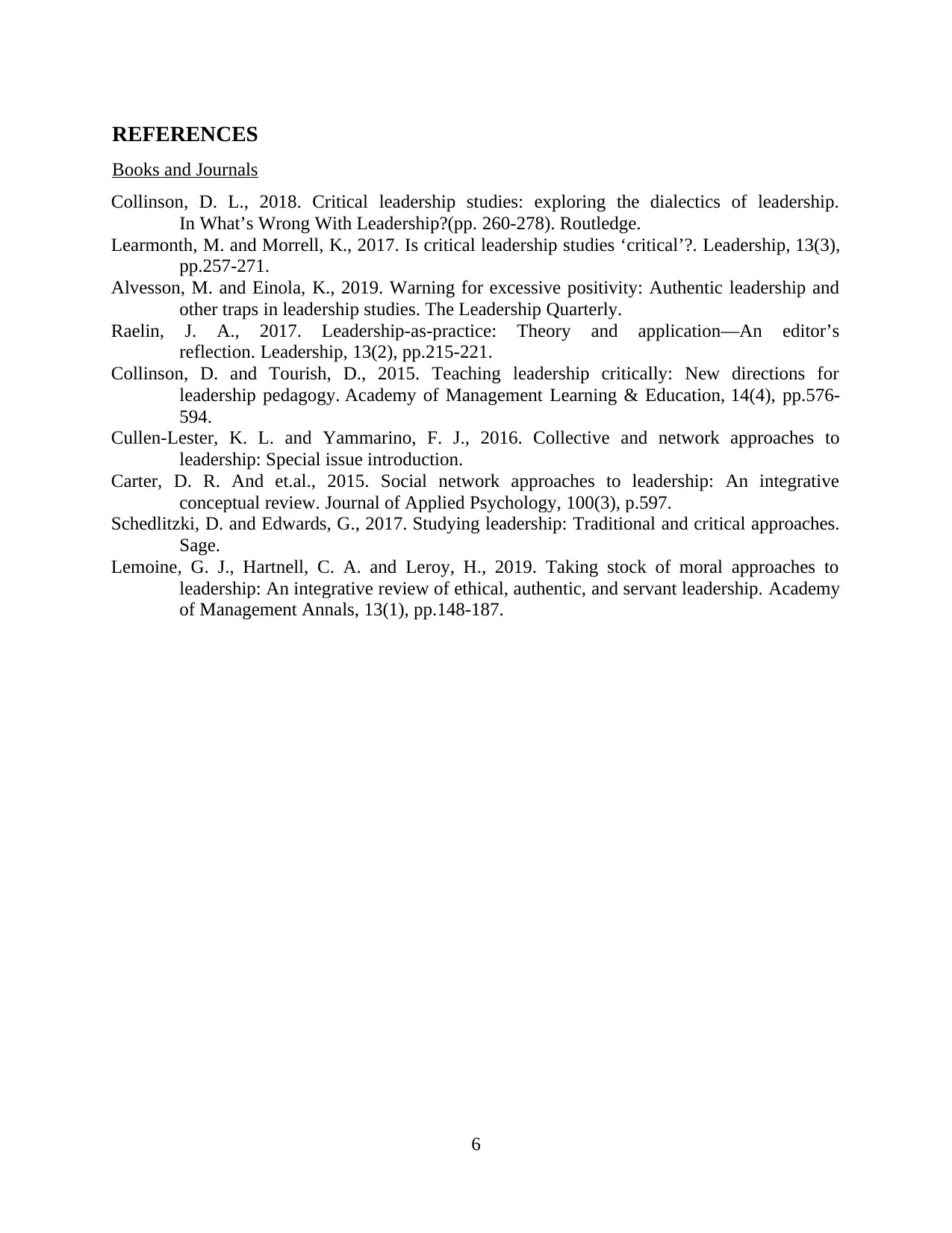
REFERENCES
Books and Journals
Collinson, D. L., 2018. Critical leadership studies: exploring the dialectics of leadership.
In What’s Wrong With Leadership?(pp. 260-278). Routledge.
Learmonth, M. and Morrell, K., 2017. Is critical leadership studies ‘critical’?. Leadership, 13(3),
pp.257-271.
Alvesson, M. and Einola, K., 2019. Warning for excessive positivity: Authentic leadership and
other traps in leadership studies. The Leadership Quarterly.
Raelin, J. A., 2017. Leadership-as-practice: Theory and application—An editor’s
reflection. Leadership, 13(2), pp.215-221.
Collinson, D. and Tourish, D., 2015. Teaching leadership critically: New directions for
leadership pedagogy. Academy of Management Learning & Education, 14(4), pp.576-
594.
Cullen-Lester, K. L. and Yammarino, F. J., 2016. Collective and network approaches to
leadership: Special issue introduction.
Carter, D. R. And et.al., 2015. Social network approaches to leadership: An integrative
conceptual review. Journal of Applied Psychology, 100(3), p.597.
Schedlitzki, D. and Edwards, G., 2017. Studying leadership: Traditional and critical approaches.
Sage.
Lemoine, G. J., Hartnell, C. A. and Leroy, H., 2019. Taking stock of moral approaches to
leadership: An integrative review of ethical, authentic, and servant leadership. Academy
of Management Annals, 13(1), pp.148-187.
6
Books and Journals
Collinson, D. L., 2018. Critical leadership studies: exploring the dialectics of leadership.
In What’s Wrong With Leadership?(pp. 260-278). Routledge.
Learmonth, M. and Morrell, K., 2017. Is critical leadership studies ‘critical’?. Leadership, 13(3),
pp.257-271.
Alvesson, M. and Einola, K., 2019. Warning for excessive positivity: Authentic leadership and
other traps in leadership studies. The Leadership Quarterly.
Raelin, J. A., 2017. Leadership-as-practice: Theory and application—An editor’s
reflection. Leadership, 13(2), pp.215-221.
Collinson, D. and Tourish, D., 2015. Teaching leadership critically: New directions for
leadership pedagogy. Academy of Management Learning & Education, 14(4), pp.576-
594.
Cullen-Lester, K. L. and Yammarino, F. J., 2016. Collective and network approaches to
leadership: Special issue introduction.
Carter, D. R. And et.al., 2015. Social network approaches to leadership: An integrative
conceptual review. Journal of Applied Psychology, 100(3), p.597.
Schedlitzki, D. and Edwards, G., 2017. Studying leadership: Traditional and critical approaches.
Sage.
Lemoine, G. J., Hartnell, C. A. and Leroy, H., 2019. Taking stock of moral approaches to
leadership: An integrative review of ethical, authentic, and servant leadership. Academy
of Management Annals, 13(1), pp.148-187.
6
1 out of 8
Related Documents
Your All-in-One AI-Powered Toolkit for Academic Success.
+13062052269
info@desklib.com
Available 24*7 on WhatsApp / Email
![[object Object]](/_next/static/media/star-bottom.7253800d.svg)
Unlock your academic potential
Copyright © 2020–2025 A2Z Services. All Rights Reserved. Developed and managed by ZUCOL.




